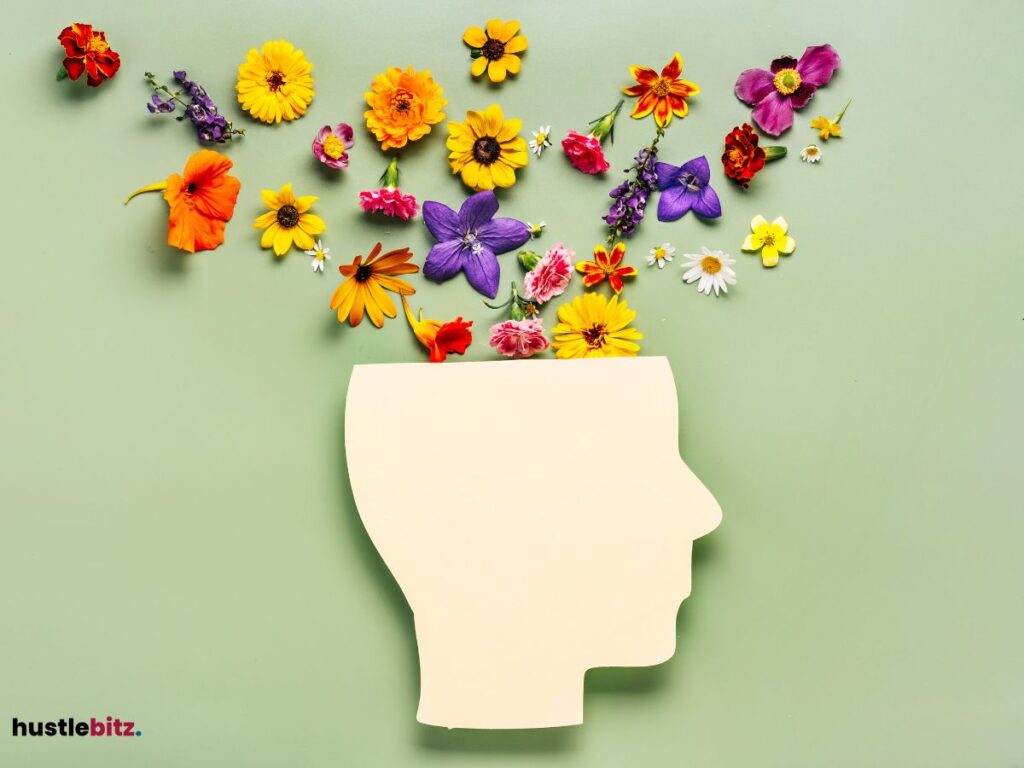Harnessing the power of visualization significantly enhances self-motivation by transforming abstract goals into clear, vivid mental images. This cognitive technique activates specific brain areas, mirroring real-life experiences and improving emotional resilience. By engaging in regular visualization, individuals can foster a success-oriented mindset and boost self-efficacy. Techniques such as vision boards and sensory detail incorporation further enrich this practice. Additionally, maintaining a consistent routine, while addressing mental barriers, reinforces motivation. Implementing these strategies cultivates a more empowering approach to goal achievement and emotional regulation. Discovering additional insights can elevate your visualization practice and its effects on your motivation journey.
Key Takeaways
- Visualization transforms abstract goals into vivid mental images, enhancing motivation and making aspirations feel more attainable.
- Engaging in daily visualization routines fosters consistency, reinforcing positive thinking and emotional resilience over time.
- Incorporating sensory details during visualization sessions enriches the experience, promoting deeper emotional connections to personal goals.
- Utilizing visualization tools, like apps and journals, supports structured practice and provides a platform for reflection and clarity.
- Overcoming mental barriers through visualization helps build confidence, allowing individuals to embrace challenges and maintain motivation in pursuing their goals.

Understanding Visualization

Visualization is a cognitive technique that involves creating vivid mental images to enhance motivation and achieve personal goals. By engaging in mental imagery, individuals can significantly improve their goal-setting processes, paving the way for greater self-awareness and emotional resilience. This technique allows practitioners to envision their desired outcomes, whether in sports performance, personal development, or professional ambitions.
At its core, visualization encourages positive thinking and fosters a mindset conducive to success. Through creative visualization, individuals can imagine themselves overcoming obstacles and achieving their aspirations, which can lead to increased motivation and a stronger belief in one’s abilities.
Visualization exercises often incorporate elements of cognitive rehearsal, whereby the mind rehearses specific scenarios to increase familiarity and preparedness, thus improving performance in real-life situations.
As individuals engage in visualization, they are not merely daydreaming but actively participating in manifesting their desires. This proactive approach transforms abstract goals into tangible mental representations, making them more attainable.
Furthermore, regular practice of visualization can enhance emotional resilience by equipping individuals with strategies to cope with challenges and setbacks.
The Science Behind Visualization

Research indicates that the brain processes mental imagery in ways similar to actual experiences, suggesting that visualization can effectively influence both cognitive and emotional pathways.
Neuroscience insights reveal that when individuals engage in mental imagery, specific areas of the brain activate as though they were experiencing the event in reality. This activation is crucial for understanding how cognitive processes related to performance enhancement and goal achievement are influenced by visualization.
The practice of visualizing success can bolster self-efficacy, as individuals mentally rehearse their actions and outcomes. This rehearsal not only reinforces belief in one’s abilities but also enhances memory retention of the skills or scenarios being visualized.
Furthermore, effective emotional regulation can be achieved through visualization techniques, allowing individuals to manage stress and anxiety. By picturing themselves in challenging situations and successfully navigating them, individuals can reduce the emotional weight of real-life stressors.
In addition to enhancing self-efficacy and emotional regulation, visualization facilitates brain activation that simulates actual performance. This phenomenon can lead to improvements in physical tasks, as the brain creates neural pathways that closely mirror those used in real-life execution.
Thus, the integration of mental imagery into one’s routine can serve as a powerful tool for stress reduction and overall performance enhancement, paving the way for individuals to achieve their goals with greater confidence and clarity.
Benefits of Visualization
Consistently employing visualization techniques can lead to significant improvements in motivation, focus, and overall performance across various personal and professional endeavors.
One of the primary benefits of visualization is its ability to facilitate effective goal setting. By creating vivid mental imagery of future goals, individuals can clarify their aspirations and reinforce their commitment to achieving them. This clarity enhances personal growth and directs efforts toward tangible outcomes.
Moreover, visualization fosters emotional resilience by allowing individuals to mentally rehearse challenging situations. This practice equips them with coping strategies, reducing anxiety and promoting stress reduction. As a result, individuals feel more prepared to face obstacles, leading to improved performance enhancement in various tasks.
Self-affirmation is another crucial aspect of visualization. By regularly visualizing success and positive outcomes, individuals cultivate a positive mindset that can transform their approach to challenges. This optimistic outlook fuels motivation and reinforces the belief in one’s capabilities, further driving personal and professional advancements.
Creative visualization serves as a powerful tool in this context. By vividly imagining success, individuals can evoke the emotions associated with achievement, making their goals feel more attainable. This emotional connection not only strengthens motivation but also enhances the overall experience of pursuing one’s ambitions.
Techniques for Effective Visualization

To harness the full potential of visualization, individuals can employ a variety of techniques that enhance clarity and effectiveness in their mental imagery practices.
One effective method is to engage in creative imagery, where one vividly imagines their future self achieving specific goals. This process not only aids in goal setting but also strengthens the emotional connection to these aspirations, making them feel more attainable.
Incorporating sensory details into visualization can significantly enhance the experience. By imagining not only the visual aspects but also sounds, smells, and tactile sensations, individuals can create a more immersive mental environment. This approach enables a more profound mental rehearsal of scenarios, allowing for greater preparedness in real-life situations.
Positive affirmations can also be integrated into visualization practices, reinforcing belief in one’s capabilities. By regularly affirming one’s strengths and successes, individuals can foster a mindset conducive to achieving their objectives.
Another powerful technique is the use of vision boards, where images and words that represent one’s goals are displayed visually. This serves as a constant reminder of aspirations, further promoting motivation and focus.
Creating a Visualization Routine
Establishing a structured visualization routine can significantly enhance an individual’s ability to stay motivated and focused on their goals. The effectiveness of visualization lies in its regular application, which can be achieved through a disciplined approach combining various visualization tools and techniques. A well-crafted routine not only aids in goal setting but also fosters a deeper connection to one’s aspirations.
To create an effective visualization routine, consider the following elements:
- Daily Practice: Dedicate a specific time each day for visualization. Consistency is key; whether it’s morning or evening, a regular schedule reinforces commitment and enhances the effectiveness of mental imagery.
- Visualization Journals: Document your visualization experiences in a journal. This practice allows for reflection on progress and can help clarify goals. Writing down your thoughts reinforces the imagery and makes it more tangible.
- Affirmations Integration: Combine visualization with positive affirmations. By articulating supportive statements while visualizing your goals, you can create a powerful synergy that boosts your motivation. This can be further enhanced with visualization apps that provide guided sessions and scripts for creative visualization.
Incorporating these elements into your routine ensures that visualization becomes a meaningful part of your daily life. By committing to routine consistency and actively engaging with visualization techniques, individuals can harness their full potential, paving the way for personal growth and achievement.
Overcoming Mental Barriers

Overcoming mental barriers is crucial for individuals seeking to fully leverage the power of visualization in their self-motivation journey. Mental obstacles such as self-doubt and confidence issues can impede progress and hinder the effectiveness of visualization techniques. These barriers often stem from limiting beliefs and negative thinking, which create a cycle of emotional resistance that can be challenging to break.
Fear management plays a vital role in addressing these mental barriers. By acknowledging and confronting fears, individuals can dismantle cognitive blocks that prevent them from fully engaging in their visualization practices. When self-sabotage becomes a pattern, it is essential to identify the underlying motivations and triggers that contribute to these behaviors.
To effectively overcome motivation barriers, one must cultivate a mindset that embraces growth and resilience. This involves shifting focus from perceived limitations to the possibilities that visualization offers. Engaging in regular self-reflection can help individuals recognize and challenge their limiting beliefs, fostering a more empowering narrative.
In essence, overcoming mental barriers requires a proactive approach to addressing emotional resistance and cognitive blocks. By developing strategies to combat self-doubt and negative thinking, individuals can enhance their confidence and unlock the transformative power of visualization.
This journey not only strengthens self-motivation but also paves the way for achieving personal and professional goals with renewed vigor and clarity.
Visualization in Daily Life

Building on the importance of addressing mental barriers, integrating visualization into daily life can significantly enhance self-motivation and goal attainment. By employing various visualization techniques, individuals can create vivid mental images of their desired outcomes, making it easier to stay focused and committed to their goals.
To effectively incorporate visualization into daily routines, consider the following strategies:
- Visualization Journaling: Dedicate time each day to write about your goals and visualize the steps required to achieve them. This practice enhances clarity and reinforces commitment.
- Visualization Apps and Tools: Utilize technology to access visualization apps that guide you through exercises designed to foster motivation and clarity. These tools often include reminders and prompts to maintain consistency.
- Join a Visualization Group or Workshop: Engaging with others in visualization workshops or groups can provide support and motivation. Sharing experiences and challenges helps create a sense of community, further enhancing the effectiveness of visualization exercises.
In addition to these strategies, participating in visualization retreats can offer immersive experiences that deepen your practice. Embracing visualization art can also serve as a creative outlet to express your aspirations visually.
Final Thoughts
Visualization is a potent strategy for enhancing self-motivation and achieving goals by transforming abstract ambitions into vivid, attainable images. Regular practice, supported by techniques such as incorporating sensory details, using positive affirmations, and creating vision boards, can boost emotional resilience and self-efficacy. By activating brain regions similar to real experiences, visualization reinforces belief in one’s abilities and improves performance. Overcoming mental barriers like self-doubt is essential to maximize these benefits. Incorporating visualization into daily routines and utilizing tools like journals and apps further solidify motivation and clarity, ultimately fostering a more empowered approach to achieving personal and professional success.




